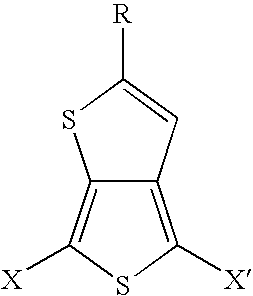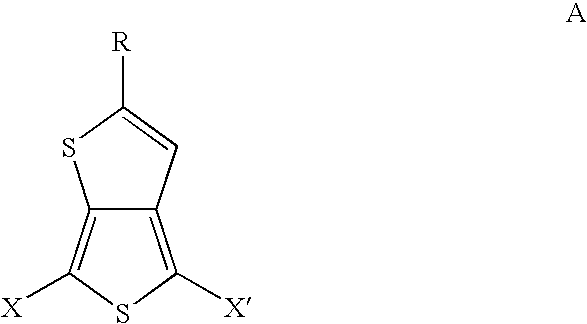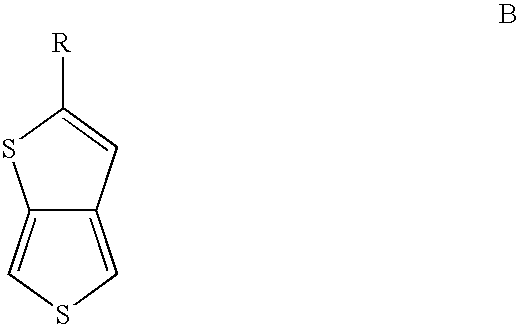Substituted thienothiophene monomers and conducting polymers
a technology of thienothiophene monomers and conducting polymers, which is applied in the direction of non-metal conductors, conductors, organic chemistry, etc., can solve the problems of limited solubility and photovoltaic properties of polymers containing dtt formed by electrochemical polymerization, and achieve low toxicity
- Summary
- Abstract
- Description
- Claims
- Application Information
AI Technical Summary
Benefits of technology
Problems solved by technology
Method used
Image
Examples
example 1
[0034] The compound 2-tert-butylthieno[3,4-b]thiophene is prepared by a two step procedure in the manner described.
Step 1
Preparation of 3-bromo-4-(3,3-dimethyl-but-1-ynyl)-thiophene
[0035] A 1-liter round-bottomed, three-necked flask was equipped with a reflux condenser, a mechanical stirrer, and a thermocouple, and static dry nitrogen gas inlet. The flask was then charged with 60 g diethylamine (which had previously been dried over powdered KOH and filtered), 96.76 g (0.40 mol.) 3,4-dibromothiophene, 500 mg (0.7 mmol) of dichlorobis(triphenylphosphine)palladium(II), 200 mg (0.76 mmol) triphenylphosphine, 150 mg (1.37 mmol) of copper(I)iodide, and 25.0 g (0.304 mol.) 3,3-dimethyl-1-butyne. The stirred mixture was heated to reflux for 7 hrs. The initial temperature was ca. 65° C. After 6.0 hrs, the temperature was ca. 70°C.
[0036] The reaction mixture was cooled to room temperature, and the diethylamine was removed by evaporation on a roto-evaporator. A 600 mL portion of mixed hexa...
example 2
Toxicity Comparison Between thieno[3,4-b]thiophene and 2-tert-butyl-thieno[3,4-b]thiophene
[0038] Thieno[3,4-b]thiophene displayed in toxicity testing an oral LD50 of 50 mg / kg and a dermal LD50 of 200-400mg / kg. 2-tert-butyl-thieno[3,4-b]thiophene on the other hand showed surprisingly lower toxicity. 2-tert-butyl-thieno[3,4-b~thiophene displayed in toxicity testing an oral LD50 of >500mg / kg and a dermal LD50 of >400mg / kg.
example 3
Chemical Polymerization of 2-tert-butyl-thieno[3,4-b]thiophene
[0039] 2-tert-butylthieno[3,4-b]thiophene (0.3 g,1.53 mmol) and imidazole (0.178 g, 2.26 mmol) were dissolved in 6 mL of n-butanol and the resulting solution was filtered through a 0.45 μm filter. Iron(III) tris-p-toluenesulfonate (2.3 g, 3.387 mmol) was dissolved in 5 mL of n-butanol and the resulting solution was filtered through a 0.45 μm filter. Both solutions were combined shortly before spin-coating them onto glass substrates (typically 2.5×2.5 cm) at 1000 rpm for 1 minute. The use of iron(III) tris-p-toluenesulfonate is advantageous because it does not crystallize. After coating, the films were dried and baked (30 min, 110° C.) in a convection furnace. After cooling down to room temperature the films were washed several times with n-butanol and deionized water to extract iron(II) salts formed at polymerization. The thickness of the films was determined to be 180 nm by profilometry. The conductivity of the resultin...
PUM
| Property | Measurement | Unit |
|---|---|---|
| temperature | aaaaa | aaaaa |
| mass | aaaaa | aaaaa |
| temperature | aaaaa | aaaaa |
Abstract
Description
Claims
Application Information
 Login to View More
Login to View More - R&D
- Intellectual Property
- Life Sciences
- Materials
- Tech Scout
- Unparalleled Data Quality
- Higher Quality Content
- 60% Fewer Hallucinations
Browse by: Latest US Patents, China's latest patents, Technical Efficacy Thesaurus, Application Domain, Technology Topic, Popular Technical Reports.
© 2025 PatSnap. All rights reserved.Legal|Privacy policy|Modern Slavery Act Transparency Statement|Sitemap|About US| Contact US: help@patsnap.com



